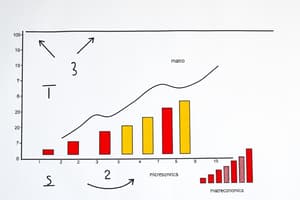Podcast
Questions and Answers
What is the primary focus of microeconomics?
What is the primary focus of microeconomics?
- National income and employment rates
- Government control over resource allocation
- Interactions among individual agents like households and firms (correct)
- Global economic trends and trade balances
What does the concept of opportunity cost refer to?
What does the concept of opportunity cost refer to?
- The monetary value of a good or service
- The value of the next best alternative foregone when making a choice (correct)
- The earnings lost from unemployment
- The total production capacity of an economy
What is the primary feature of a market economy?
What is the primary feature of a market economy?
- Prices are set by government regulations
- Resource allocation is centrally controlled by the state
- Decisions are made by individuals and the market (correct)
- Production is based on customs and traditions
Which economic theory advocates for government intervention in times of economic downturns?
Which economic theory advocates for government intervention in times of economic downturns?
What does fiscal policy primarily involve?
What does fiscal policy primarily involve?
Flashcards are hidden until you start studying
Study Notes
Key Concepts of Economics
-
Definition: Economics is the study of how individuals, businesses, and societies allocate limited resources to satisfy unlimited wants.
-
Branches:
- Microeconomics: Focuses on individual agents, such as households and firms, and their interactions in markets.
- Macroeconomics: Examines the economy as a whole, including national income, inflation, and unemployment rates.
Fundamental Concepts
- Scarcity: The limited nature of society's resources; leads to the need for choices.
- Supply and Demand:
- Demand: Quantity of a good or service consumers are willing to purchase at various prices.
- Supply: Quantity that producers are willing to sell at various prices.
- Equilibrium: Point where supply equals demand.
- Opportunity Cost: The value of the next best alternative foregone when making a choice.
- Incentives: Factors that motivate individuals to act in certain ways, influencing economic choices.
Economic Systems
- Traditional Economy: Based on customs and traditions, often rural and subsistence-oriented.
- Command Economy: Centralized government control over production and resource allocation (e.g., communism).
- Market Economy: Decisions made by individuals or the market; prices determined by supply and demand.
- Mixed Economy: Combination of market and command economy features.
Key Economic Indicators
- Gross Domestic Product (GDP): Total value of goods and services produced within a country.
- Unemployment Rate: Percentage of the labor force that is jobless and actively seeking employment.
- Inflation Rate: Rate at which the general level of prices for goods and services is rising.
Important Economic Theories
- Classical Economics: Emphasizes free markets and the idea that economies are self-regulating.
- Keynesian Economics: Advocates for government intervention during economic downturns to stimulate demand.
- Monetarism: Focuses on the role of government in controlling the amount of money in circulation.
- Behavioral Economics: Examines psychological factors that influence economic decisions.
Policy Tools
- Monetary Policy: Adjusting interest rates and money supply to influence the economy.
- Fiscal Policy: Government spending and tax policies used to influence economic conditions.
- Trade Policy: Regulations and tariffs governing international trade.
Current Trends
- Globalization: Increasing interdependence of national economies through trade, investment, and technology.
- Sustainability: Economic practices aimed at meeting current needs without compromising future generations.
Economic Challenges
- Recession: A period of economic decline characterized by falling GDP and rising unemployment.
- Inflation vs. Deflation: Inflation increases prices; deflation decreases them, both impacting purchasing power.
- Income Inequality: The unequal distribution of income within a population, leading to social and economic tensions.
Economics: The Study of Choice
- Economics deals with how individuals, businesses, and societies use limited resources to satisfy unlimited wants.
- It explores how people make decisions in the face of scarcity.
Micro vs. Macro
- Microeconomics examines individual economic choices, like consumer behavior and firm decisions in specific markets.
- Macroeconomics analyzes the global picture, including national income, inflation, and unemployment.
Fundamental Concepts
- Scarcity: The basic economic problem, meaning resources are finite, but desires are endless.
- Supply and Demand: These forces determine market prices.
- Demand: Consumers' willingness and ability to buy at various prices.
- Supply: Businesses' willingness and ability to sell at various prices.
- Equilibrium: The point where supply and demand balance, setting the market price.
- Opportunity Cost: The value of the best alternative forfeited when making a choice. This helps evaluate the true cost of decisions.
- Incentives: Factors that motivate individuals to act. These can be positive (rewards) or negative (penalties), and influence economic choices.
Economic Systems
- Traditional Economy: Rooted in customs and traditions, often in rural, subsistence-oriented societies.
- Command Economy: Centralized government control over production and resource allocation, as seen in communism.
- Market Economy: Decisions driven by individuals and market forces, with prices determined by supply and demand.
- Mixed Economy: Combines elements of market and command economies, representing a balance between individual and government control.
Key Economic Indicators
- Gross Domestic Product (GDP): The total value of goods and services produced within a country's borders, reflecting its economic activity.
- Unemployment Rate: The percentage of the labor force actively seeking jobs but unable to find them.
- Inflation Rate: The rate at which prices for goods and services rise over time, impacting purchasing power.
Important Economic Theories
- Classical Economics: Advocates for free markets and self-regulating economies, emphasizing individual choices and minimal government intervention.
- Keynesian Economics: Supports government intervention during economic downturns to stimulate demand through spending and fiscal policies.
- Monetarism: Focuses on the role of the government in managing the money supply to influence economic activity.
- Behavioral Economics: Investigates psychological factors influencing economic decision-making, acknowledging that individuals aren't always rational.
Policy Tools
- Monetary Policy: Used by central banks to influence economic activity by adjusting interest rates and controlling the money supply.
- Fiscal Policy: Government decisions about spending and taxation to stimulate or slow down economic growth.
- Trade Policy: Regulations and tariffs set by governments to influence international trade.
Current Trends
- Globalization: Increasing economic interconnectedness through trade, investment, and technology.
- Sustainability: Economic practices aimed at meeting current needs without compromising future generations' ability to thrive.
Economic Challenges
- Recession: A period of economic decline marked by falling GDP, rising unemployment, and reduced business activity.
- Inflation vs. Deflation:
- Inflation: A general increase in prices, eroding purchasing power.
- Deflation: A general decrease in prices, potentially hampering economic growth.
- Income Inequality: Uneven distribution of income within a population, raising social and economic tensions.
Studying That Suits You
Use AI to generate personalized quizzes and flashcards to suit your learning preferences.




